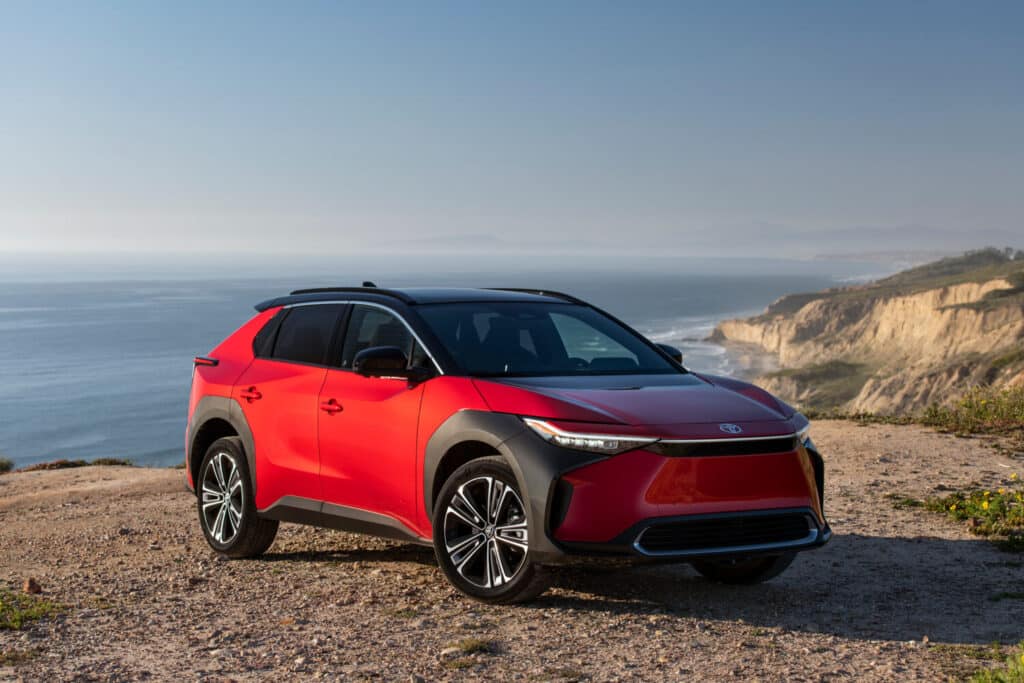How OEMs are Dealing with Tariff Uncertainty After Stock Market Plummets
The administration’s sweeping new “Liberation Day” tariffs on all imports have sent shockwaves through the stock markets, igniting fears that the automotive industry might see steep price hikes across various powertrain types. The plan established a 10% baseline tariff on almost every country, though many nations such as China, Vietnam and Taiwan are subject to much steeper rates. A Cato Institute report based on World Trade Organization data said the trade-weighted average tariff rates imposed by most countries are much lower than what the administration said.
The reciprocal tariffs threaten to increase automotive prices significantly. However, not all automakers are reacting in panic. On Friday, Toyota, Honda, and Hyundai made it clear that they are keeping prices steady for now—offering consumers some stability amidst the uncertainty, as the Dow’s recent plunge caused by the tariff announcement resulted in its largest consecutive losses since the onset of the Covid-19 pandemic in March 2020.
Hyundai and Genesis Launch Initiatives to Protect MSRP Amid Market Uncertainty
In a proactive move to support customers during uncertain market conditions, Hyundai Motor America and Genesis Motor America have introduced two new initiatives on April 4, 2025, aimed at providing financial peace of mind to buyers and lessees of their vehicles.
Hyundai has launched the Customer Assurance program, while Genesis has rolled out the Genesis Cares initiative, both designed to lock in the Manufacturer’s Suggested Retail Price (MSRP) for the entire lineup of vehicles for the next two months. This means that any customer who purchases or leases a new Hyundai or Genesis vehicle from now through June 2, 2025, will not experience any price increases, regardless of fluctuations in market conditions or potential impacts from tariffs on the automotive industry.
“At Hyundai, we have a long history of providing value and doing what’s right for our customers and communities,” said José Muñoz, president and CEO, Hyundai Motor Company. “We know consumers are uncertain about the potential for rising prices and we want to provide them with some stability in the coming months. Our MSRP commitment is just one part of our multifaceted effort to provide great vehicles to American consumers, while also supporting hundreds of thousands of jobs and investing billions of dollars in the most important market for our company.”

Why This Matters: Tariff Uncertainty
By locking in the MSRP for the next two months, Hyundai and Genesis are taking a significant step to protect their customers from unexpected price hikes, which could otherwise create financial uncertainty in an already volatile market. Whether customers are looking to purchase or lease a new vehicle, they can now proceed with confidence, knowing that their vehicle price is secured for the duration of the protection window.
“At Genesis, we strive to treat every customer as our ‘son-nim’, or honored guest,” said Tedros Mengiste, chief operating officer of Genesis Motor North America. “Despite dynamic market conditions, the brand remains firm in its commitment to delivering an elevated sales and ownership experience for U.S. customers.”
“Our commitment to maintaining the MSRP is another example of the focus we place on the consumer,” said Randy Parker, CEO, Hyundai Motor North America. “We understand the challenges consumers face in today’s economic climate, and we want to continue the momentum from record sales in March and the first quarter. This initiative builds on Hyundai’s legacy of supporting American consumers and investing in the U.S. market.”
Toyota Keeping Prices Steady for Now
Toyota reacted to the tariffs by committing to keeping its prices steady for now. The decision is part of the automaker’s efforts to protect both its customers and its business interests in the U.S. market.
A Toyota spokesperson confirmed the company’s stance, stating, “We’ll keep our operations running as they are for now.” This statement, made to Nikkei, reassures consumers and industry analysts alike that Toyota does not plan to raise prices, despite the looming costs that could result from the new tariffs.

Navigating the Impact of Tariffs
The recent tariff announcements primarily affect automotive parts imported from Canada and Mexico, two crucial partners for the U.S. car manufacturing industry. While Toyota operates a vast manufacturing network in the U.S., its supply chain is heavily globalized, with many components sourced from overseas. The tariffs, which could cost the country’s six largest automakers up to $24 billion, would disproportionately affect Toyota, with estimates suggesting the company could bear about $12 billion of the total financial burden.
Despite this, Toyota has pledged to help its suppliers manage the increased costs. The company confirmed it would cover the higher parts costs its suppliers will face due to the tariffs, an effort aimed at preventing disruptions to its production and maintaining price stability for customers.
This approach is a critical move for Toyota, as it tries to balance the pressures of higher operational costs with the desire to stay competitive in an already tight market. Maintaining stable prices could help Toyota retain its customer base and protect its brand reputation, especially as consumers become more sensitive to price changes in the wake of the tariff news.
The decision also signals that, while Toyota’s manufacturing footprint in the U.S. is substantial, the global nature of the automotive supply chain means that no brand is truly immune to the ripple effects of international trade policies.
Honda Will Not Make Immediate Price Adjustments
A spokesperson for Honda indicated that the company is closely monitoring the impact of the tariffs but has not yet decided to alter its pricing structure. This approach reflects Honda’s flexibility in responding to market conditions, especially as the full effects of the tariffs remain to be seen. Honda is choosing to take a more conservative stance, avoiding any knee-jerk reactions while awaiting clearer insights into how the tariffs will impact costs and consumer demand. Along with Toyota, Honda’s statement was made to Nikkei.

Mazda: A Bigger Risk in the Tariff Storm
While Toyota and Honda have the means to absorb some of the tariff-related costs, smaller players like Mazda could be more vulnerable. Mazda, which imports most of its vehicles to the U.S. from Japan and Mexico, may feel the sting of the tariffs more acutely. Beyond the CX-50 crossover, which is produced in a joint venture plant with Toyota in Huntsville, Alabama, most of Mazda’s offerings come from abroad. This reliance on foreign manufacturing makes the automaker more susceptible to the additional costs imposed by the tariffs.
Mazda’s situation is a reminder that the ripple effects of tariff changes are not felt equally across all automakers. Larger companies like Toyota and Honda, with expansive manufacturing operations in the U.S. and deeper resources, can more easily absorb some of the increased costs. In contrast, smaller brands with a global supply chain and limited U.S. production capacity may face tougher challenges in managing the financial burden without resorting to price hikes.
Ford Launches New Employee Discounts
On April 3, 2025, Ford launched its “From America, For America” campaign, a new initiative aimed at promoting Ford’s American-made vehicles. The campaign includes some attractive offers, including steep discounts. For example, a Ford dealer shared with The Detroit Free Press that a Ford F-150 XLT hybrid, typically priced at $65,000, would be available for $55,000 under the employee pricing plan.
Stellantis Also Offering Employee Discounts, While pausing Production at Plants in Canada and Mexico
Multinational auto manufacturer Stellantis announced on Friday that it would begin offering employee discounts to the public. This move is designed to help cushion the financial impact of the new tariffs.
Stellantis’ initiative, called “America’s Freedom of Choice,” allows customers to purchase vehicles at “employee price or current cash incentives.” The program is designed to give consumers a chance to save on their vehicle purchases amidst the price hikes expected from the tariffs. A Stellantis spokesperson explained that customers should visit their local dealers to determine the best offer available to them, depending on their specific needs and vehicle choices.
The “America’s Freedom of Choice” program will be available until April 30, providing a temporary window for consumers to take advantage of discounted prices before the full effect of the tariffs starts to hit car prices.
A temporary layoff was announced as well. Among those to be laid off at Stellantis are 900 US hourly employees who make powertrains and stampings that supply the affected Canadian and Mexican plants, Stellantis said Thursday. The temporary layoffs are due to reduced production due to the tariffs.
Antonio Filosa, Stellantis’ chief operating officer for the Americas, confirmed that a pause in production would “impact some employees” at several of their U.S. powertrain and stamping facilities. As part of its efforts to mitigate the impact of the tariffs, Stellantis is adjusting its operations to ensure that it can continue to manage both costs and workforce requirements effectively.
The decision to pause production also comes as Stellantis faces a significant decline in U.S. sales, with the company reporting a 12 percent year-over-year drop in sales for the first quarter of 2025. This decline in sales, combined with rising operational costs due to the tariffs, puts additional pressure on the company’s bottom line as it navigates a challenging year ahead.
Jaguar Land Rover pauses U.S. shipments
On April 6, 2025, CNBC reported that British carmaker Jaguar Land Rover said it will pause U.S. shipments for a month as it assesses the impact of U.S. tariffs on vehicle imports. As one of Britain’s biggest carmakers, the company described the U.S. as “an important market” for the firm’s luxury brands.
“As we work to address the new trading terms with our business partners, we are enacting our planned short-term actions including a shipment pause in April, as we develop our mid- to longer-term plans,” a spokesperson for Jaguar Land Rover told CNBC.
The S&P 500 Shed $5.06 Trillion in Market Value Across Two Days
On April 4, 2025, CNN reported that U.S. stocks were hit hard, suffering steep losses after China retaliated against the United States for its tariffs. This back-and-forth, a classic example of a tit-for-tat response, deepened fears that the global trade war could escalate further, potentially pushing global economies into a recession.
“The challenge these tariffs are going to present is that they are almost certainly going to raise the cost of living for Americans at least in the short-term,” Republican pollster and strategist Kristen Soltis Anderson told CNN’s Kasie Hunt.
But the administration so far is making only unspecific warnings about short term disruption, and still isn’t conceding Americans will face price hikes. The rudimentary formula that was used to arrive at bewildering tariff rates deepened fury among US trading partners.
“They know nothing,” veteran Wall Street trader Peter Tuchman told CNN’s Erin Burnett.
“The formula they used … it’s like apples, oranges, a couple of cashews divided by 10 times four.” He added: “None of it makes any sense and billions and trillions of dollars are being wiped out of the market on a day-to-day basis. It was nothing but blood on the streets.”
The Dow Jones Industrial Average plummeted by an eye-watering 2,231 points, or 5.5%. Meanwhile, the broader S&P 500, a key benchmark of the U.S. stock market, fell by 5.97%. The technology-heavy Nasdaq Composite, which had already faced turbulence in recent months, saw a 5.82% drop, pushing the index into bear market territory for the first time since 2022. This marks a significant milestone, as the Nasdaq is now down more than 20% from its record high set in December.
The situation for the Dow was similarly grim. It closed in correction, down more than 10% from its own peak in December. This marked the first time the index had fallen into correction territory since March 7, 2022, when it was impacted by broader market turmoil. The Dow’s recent plunge also resulted in its largest consecutive losses since the onset of the Covid-19 pandemic in March 2020, a time when investor sentiment was at rock bottom due to the uncertainty caused by the global health crisis.
The S&P 500 wasn’t spared, either. Over the span of just two days, the benchmark index shed a staggering $5.06 trillion in market value, according to Howard Silverblatt, senior index analyst at S&P Dow Jones Indices. The losses were a direct result of heightened market volatility, with the S&P 500 entering correction territory on Thursday and suffering more than a 10% drop in a mere 48 hours.
These massive market swings have sent shockwaves through the investment community, as many worry about the broader economic implications. Investors are increasingly concerned that the trade war could spiral out of control and eventually trigger a recession in both the U.S. and the global economy.
Analysts at JPMorgan warned just days before the sell-off that both the U.S. economy and the world economy had a 60% chance of slipping into a recession this year. These fears only intensified with China’s retaliatory measures, which many believe will make it harder for the two countries to come to the negotiating table. With no sign of the conflict abating, the risk of further escalation grows, and hopes for a diplomatic resolution are fading.
Economists and economic experts universally panned the “Liberation day” tariffs. Trade historian Douglas Irwin predicted that the damage will be geopolitical as well as economic in an article for the Economist.
Irwin said in his article: “The president now touts his tariffs as mainly “reciprocal”: “whatever they charge us, we charge them.” This makes them sound fair. Far from it. The calculated tariffs did not measure tariffs or non-tariff barriers facing American exporters. They were, instead, based on the bilateral trade balance with each country—merchandise only, excluding services, in which America tends to run a surplus. According to the US Trade Representative’s office, the calculation of the tariffs “assumes that persistent trade deficits are due to a combination of tariff and non-tariff factors that prevent trade from balancing”. The implicit goal here is balanced trade on a bilateral basis.
This is bonkers, akin to an individual trying to have balanced trade with the local grocery store (with which she runs a large trade deficit) as well as with her employer (with which she runs a large trade surplus). There may be reasons to seek overall trade balance, but there is no rationale for balancing trade on a bilateral basis.
And seeking to balance overall trade through bilateral measures misses the macroeconomic nature of that imbalance, including the role of America’s large fiscal deficit in driving the flow of capital to the country. Of course, the trade deficit may narrow if America slips into a recession—hardly the outcome anyone hopes for.”
The events of this week have underscored just how sensitive the global markets are to geopolitical tensions, especially when it comes to trade. As the U.S. and China continue to exchange economic blows, the long-term effects on market stability remain uncertain, leaving investors and economists alike on edge.
“Markets may actually be underreacting, especially if these rates turn out to be final, given the potential knock-on effects to global consumption and trade,” said Matt Burdett, head of equities at Thornburg Investment Management. “The tariffs have injected a level of uncertainty and volatility we haven’t seen since the early days of the pandemic.”
EVinfo.net’s Take: Stop the Penguin Tariffs
The tariffs were ridiculed for including several territories so remote that they don’t have any permanent human residents. One prime example is the Heard Island and McDonald Islands, an external Australian territory. The extremely remote islands, which are located in the southwest Indian Ocean about halfway between Australia and South Africa, are home only to a large populations of marine birds and mammals, including seals, albatrosses and penguins.
EVinfo.net agrees with trade historian Douglas Irwin and economists that the tariffs are indeed “bonkers.” We believe these tariffs will only raise prices for Americans for a years-long period, while not accomplishing the goal of bringing more manufacturing jobs to the US in any significant numbers. Inflation is likely to pick up because of the tariffs, and could remain elevated, Federal Reserve Chair Jerome Powell said Friday, and we agree with that statement. Bipartisan legislation is underway to reassert Congress’ authority over tariffs, and we hope it succeeds.
EVinfo.net commends Hyundai and Genesis for their initiatives, both designed to lock in the Manufacturer’s Suggested Retail Price (MSRP) for their entire lineup of vehicles for the next two months. We are also glad Ford and Stellantis are offering discounts, and that Honda and Toyota will keep prices unchanged for now. In periods of economic turmoil and massive stock market losses, consumers worry about how these events will impact their personal finances, and therefore put plans to buy or lease big-ticket items such as vehicles on hold.
These initiatives by automakers give consumers some confidence that they can take their time in making a big decision such as buying or leasing a new vehicle, without the added pressure of price increases. On March 26, ABC News reported industry analysts predict that the average price of a new imported car could rise by $6,000, after the imposition of a 25% tariff on all imported cars. These vehicle prices could now increase substantially, given the new tariffs announced this week.
Many buyers are stepping up plans to buy sooner than later, given the price increases that are likely to come. The federal EV tax credit of up to $7,500 is still available, although it may be cut soon. Now may be a great opportunity to get that EV you’ve been thinking about. EVinfo.net recommends fast, fun, reliable and high-quality EVs by Ford, Hyundai/Kia, Rivian, BMW, Mercedes-Benz, GM, Porsche, Volkswagen, Lucid Motors, Audi, Mini Cooper, Polestar, Volvo, Jeep, and Honda.


Electric Vehicle Marketing Consultant, Writer and Editor. Publisher EVinfo.net.
Services